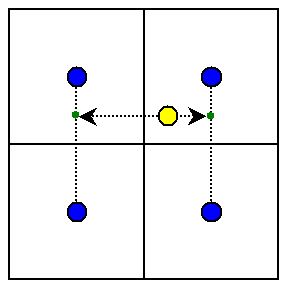
In the one-dimensional case, the value at the yellow point is calculated as
6.8 y/(x+y) + 2.4 x/(x+y)
This online system generates meteorological data for use with SEIB-DGVM version 3.00 and later. The generator is based on the Earth system model MIROC6.
Citation information for this climate data can be found on the following page:
ISIMIP3b bias-adjusted atmospheric climate input data
7 Oct 2025
The data converter of MIROC6 for inputting the SEIB-DGVM ver3.0 and later is now open to the public.
1. This web system may be used by any individual or organization for legitimate and fair purposes.
2. The data are provided without any guarantees regarding the accuracy, correctness, or usefulness of the generated output.
3. Publications should properly cite the original climate dataset.
4. We would appreciate it if you could include acknowledgments to Dr. Hideki NINOMIYA [ORCiD] (Max Planck Institute) and Dr. Hisashi SATO [ORCiD] (JAMSTEC).
This system uses data that Dr. Ninomiya downloaded from the above website and converted into a format suitable for large-scale simulations with SEIB (daily data on a global 0.5° grid, comprising seven meteorological variables).
Dr. Sato developed this system, which performs bilinear interpolation on that formatted dataset.
From coarse (0.5-degree global) original data, this web system generate climate data for your specified location using simple liner interpolation, as illustrated below.

In the one-dimensional case, the value at the yellow point is calculated as
6.8 y/(x+y) + 2.4 x/(x+y)

To obtain the interpolated value at your selected location, the system refers to the four nearest grid points.
First, the values at the green dots are computed by linear interpolation in one direction.
Then, the same method is applied in the perpendicular direction to obtain the value at the yellow point.
This process is known as bilinear interpolation.
Under conditions of low air temperature, when the saturated vapor pressure becomes extremely small, the output value of relative humidity was unstable, frequently fluctuating between 0% and 100%. Therefore, I modified the system so that it always outputs 100% when the air temperature falls below -25℃.